Bakrie Sumatera Plantations
hideThis article has multiple issues. Please help or discuss these issues on the talk page. (Learn how and when to remove these template messages)
|
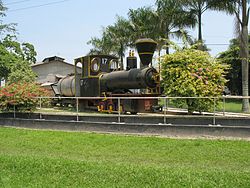 Monument at Bakrie Sumatera Plantations, July 2008 | |
| Type | Subsidiary |
|---|---|
| Industry | Agriculture Transportation |
| Founded | 1911 Kisaran, Indonesia |
| Headquarters | Lampung, Indonesia |
| Products | Rubber Palm oil |
| Parent | Bakrie Group |
| Website | BakrieSumatera.com |


Bakrie Sumatera Plantations is an agricultural subsidiary of Bakrie Group headquartered in Lampung, Indonesia. Bakrie Sumatera Plantations manages an estimated one hundred thousand hectares of rubber and palm oil plantations,[1] a railroad for transporting rubber, and several land banks.[2]
History[]
Bakrie Sumatera Plantations was founded in 1911 as N.V. Hollandsch Amerikaanse Plantage Maatschappij, opening its first rubber plantation in Kisaran.[3] In the late 1910s, the company was acquired by United States Rubber Plantation Inc., Sumatra, a subsidiary of United States Rubber Company (USRC). In 1986 Bakrie Group acquired the company from USRC, renaming it to "PT Bakrie Sumatera Plantations" in 1990.[4]
In 1990, Bakrie Sumatera Plantations opened a palm oil plantation in Pasaman, and acquired another one in Bah Jambi from P.T. Agrowiana the next year. In 1992 Bakrie Sumatera Plantations began converting several of its rubber plantations into palm oil plantations due to palm oil's higher profitability and greater endurance of climate change.[5] While the company's palm oil plantations do not make use of its railroad system, as of 2016, Bakrie Sumatera Plantations still used its railroad to transport rubber.
Rolling stock[]
The first engines delivered to the company, all 0-6-0T engines, were one Vulcan Iron Works engine, two Davenport engines, and three Orenstein and Koppel engines. In the early 1950s, the company acquired ten Ruston Hornsby engines, its first diesel engines. These engines were scrapped around 2006. Currently, Bakrie Sumatera Plantations operates engines built by Ruston Hornsby, Schöma, and Diema.
Locomotives[]
Current[]
| Name | Wheel arrangement | Builder & Type ( Builder number / Year built ) | Notes | Photograph |
|---|---|---|---|---|
| D 9 | 0-4-0DM | Ruston 48DL ( 425331 / 1954 ) | in use | 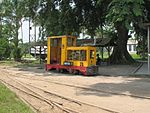
|
| D 11 A | 0-4-0DM | Schöma CFL45B ( 4872 / 1986 ) | in use | 
|
| D 12 | 0-4-0DH | Diema DFL60-1.2 ( 4140 / 1978 ) | in use | 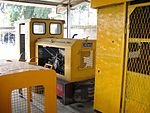
|
| D 14 | 0-4-0DH | Schöma CFL45B ( 4438 / 1980 ) | inspection | |
| D 15 | 0-4-0DH | Schöma CFL45B ( 4713 / 1983 ) | in use | 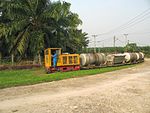 | |
|
| D 16 | 0-4-0DH 1,067 mm (3 ft 6 in) |
Schöma CFL60DCL ( 4950/ 1987 ) | in use | 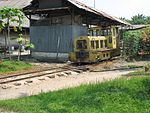
|
Former[]
| Name | Wheel arrangement | Builder & Type ( Builder number / Year built ) | Notes | Photograph |
|---|---|---|---|---|
| 17 | 0-6-0T | →Orenstein & Koppel 40 HP ( 7067 / 1919 ) | monument | 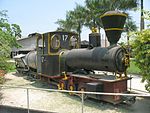
|
| D 7 | 0-4-0DM | Ruston 48DL ( 349498 / 1954 ) | dumped | 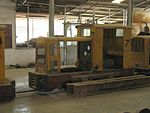
|
| D 10 | 0-4-0DM | Ruston 48DL ( 441569 / 1954 ) | dumped | 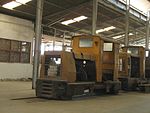
|
See also[]
References[]
- ^ "PT Bakrie Sumatera Plantations TBK | Member | RSPO - Roundtable on Sustainable Palm Oil". rspo.org. Retrieved 2016-05-30.
- ^ Helena Varkkey, The Haze Problem in Southeast Asia (Abingdon: Routledge, 2015), p. 77
- ^ "PT. Bakrie Sumatera Plantations tbk - Background". Archived from the original on 2017-02-02. Retrieved 2017-01-29.
- ^ The Business Watch Indonesia: BIOFUEL INDUSTRY IN INDONESIA
- ^ Indonesia News - EMBASSY OF THE REPUBLIC OF INDONESIA IN ANKARA, TURKEY, Volume IV October 2007
Coordinates: 3°0′10.02″N 99°36′6.53″E / 3.0027833°N 99.6018139°E
Links[]
![]() Media related to Bakrie Sumatera Plantations Railway at Wikimedia Commons
Media related to Bakrie Sumatera Plantations Railway at Wikimedia Commons
- Rail transport in Indonesia
- Transport in Sumatra
- Transport in Lampung
- Palm oil companies of Indonesia
- Bakrie Group
- Companies based in Lampung
- Agriculture companies established in 1911
